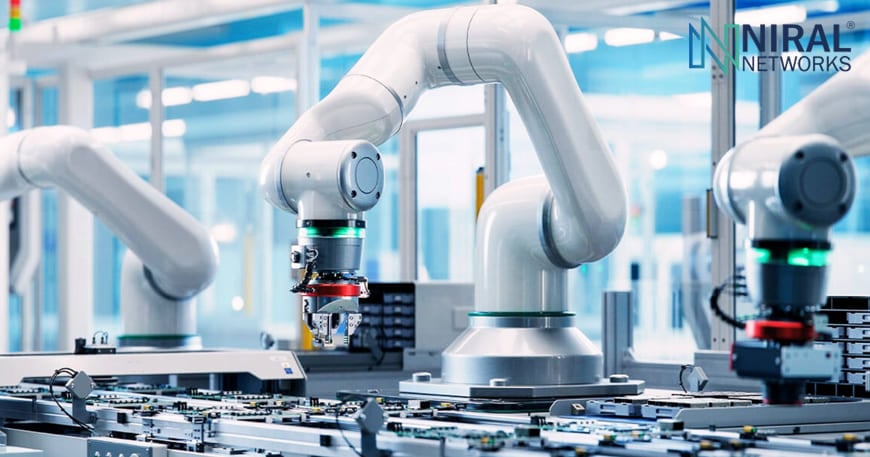Imagine a world where industrial robots don’t just execute pre-programmed tasks – they learn, adapt, and evolve in real-time. This isn’t science fiction; it’s the revolutionary reality being shaped by Digitalization as a Service (DaaS). As manufacturing facilities worldwide grapple with increasing complexity and demand for customization, OEMs in the robotics industry stand at a crucial crossroads. The question isn’t whether to embrace digital transformation – it’s how to implement it effectively while staying ahead of the competition. The convergence of IT networks, edge computing, and industrial automation has unleashed a new paradigm that’s redefining the possibilities of what robots can achieve in modern manufacturing.
The Evolution of Industrial Robotics in the Digital Age
Traditional robotics deployments often operated in isolation, with limited connectivity and intelligence. However, the emergence of Industry 4.0 has fundamentally changed this landscape. Modern robotic systems require seamless integration with enterprise networks, real-time data processing capabilities, and intelligent decision-making frameworks. This evolution has created a pressing need for comprehensive digital solutions that can bridge the gap between operational technology (OT) and information technology (IT).
Understanding Digitalization as a Service
DaaS represents a paradigm shift in how OEMs approach digital transformation. Rather than treating digitalization as a one-time project, DaaS offers a continuous, scalable approach to implementing and managing digital solutions. This model provides several key advantages:
Seamless Integration
By leveraging advanced networking solutions and edge computing capabilities, DaaS enables OEMs to integrate their robotic systems with existing enterprise infrastructure seamlessly. This integration ensures smooth data flow between shop floor operations and enterprise systems, creating a unified digital ecosystem.
Scalability and Flexibility
Modern industrial networks must adapt to changing requirements while maintaining optimal performance. DaaS platforms provide the flexibility to scale operations up or down based on demand, ensuring efficient resource utilization and cost-effectiveness.
Enhanced Security
With increasing connectivity comes greater security challenges. DaaS incorporates robust security frameworks that protect sensitive industrial data while enabling secure remote access and monitoring capabilities.
The Critical Role of IT Networks in Digital Transformation
The backbone of successful digitalization lies in robust and intelligent IT networks. As enterprises expand their digital footprint, the network infrastructure must evolve to support:
High-Performance Connectivity
Modern robotic systems generate massive amounts of data that requires real-time processing. Advanced networking solutions ensure low-latency communication between devices, edge nodes, and central systems.
Network Segmentation and Quality of Service
Intelligent network management enables prioritization of critical traffic while maintaining isolation between different operational zones, ensuring optimal performance for mission-critical applications.
Software-Defined Networking
SDN capabilities allow for dynamic network configuration and management, enabling automated responses to changing operational requirements and ensuring optimal resource allocation.
Edge Computing: The Gateway to Real-Time Intelligence
The rise of edge computing has transformed how robotic systems process and act on data. By bringing computational power closer to the data source, edge computing enables:
Real-Time Decision Making
Edge nodes process critical data locally, enabling immediate response to operational conditions without the latency of cloud communication.
Reduced Bandwidth Requirements
By processing data at the edge, organizations can optimize network bandwidth usage while maintaining high-performance operations.
Enhanced Reliability
Edge computing architecture ensures continued operation even during network disruptions, maintaining critical functions and data collection.
Implementing DaaS: Best Practices and Considerations
Successful implementation of DaaS requires a strategic approach that considers both technical and operational factors:
Assessment and Planning
Begin with a comprehensive assessment of existing infrastructure and future requirements. This evaluation should consider network capacity, security requirements, and integration needs.
Phased Implementation
Adopt a staged approach to digital transformation, prioritizing high-impact areas while maintaining operational continuity.
Continuous Monitoring and Optimization
Implement robust monitoring solutions to track system performance and identify optimization opportunities proactively.
The Future of Industrial Robotics with DaaS
As technology continues to evolve, DaaS will play an increasingly crucial role in shaping the future of industrial robotics. Key trends include:
AI-Driven Automation
Integration of artificial intelligence and machine learning capabilities at the edge will enable more autonomous and adaptive robotic systems.
Enhanced Connectivity
The adoption of advanced networking technologies, including 5G and Wi-Fi 6, will provide faster, more reliable connectivity for industrial applications.
Greater Integration
Deeper integration between OT and IT systems will enable more comprehensive digital twins and predictive maintenance capabilities.
Conclusion
Digitalization as a Service represents a fundamental shift in how OEMs approach digital transformation in the robotics industry. By leveraging advanced networking solutions, edge computing capabilities, and intelligent automation frameworks, organizations can accelerate their digital journey while maintaining operational excellence.
For OEMs looking to stay competitive in today’s rapidly evolving industrial landscape, partnering with experienced technology providers like Niral Networks can provide the expertise and solutions needed to succeed. With our comprehensive suite of networking solutions, edge computing platforms, and professional services, we help organizations navigate the complexities of digital transformation while maximizing the value of their robotics investments.
Contact Niral Networks today to learn how our innovative solutions can help your organization embrace the future of industrial automation.





